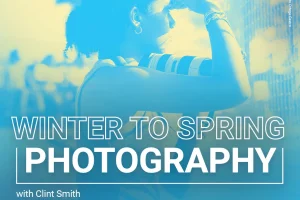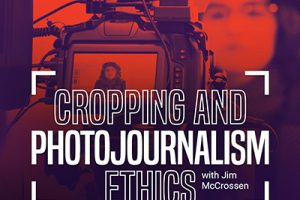Photo Quest – What NOT to shoot
Much teaching time in photography – especially on the high school level – is spent on looking for the right moment to shoot. But examining the flip side of that concept – what not to shoot – may be just as helpful in pursing good images, so that photographers understand what does not work, what has been overused or what may put us on shaky ground legally or ethically.
Clichés
Two typical images that appear in yearbook academic coverage are the teacher sitting at the desk and the principal or secretary talking on the phone. Problems with these photos include:
- They either appear to be staged or are outright fake.
- They reveal the photographer’s absence of creative vision and the editor’s lack of creative planning.
- These photos just are not interesting; hence, clichés.
Rules should exist in your photo staff manual against staged or posed shots. Writers should not make up quotes; likewise, shooters should not fake pictures.
Another clichéd picture arrived on the school scene in tandem with the computer – the student sitting, staring at a computer screen. With computers permeating the curriculum, how do you cover computer use? Patience is key. A student working at a computer will eventually give a facial expression – concentration, frustration, joy – that will improve a mundane, clichéd image.
Composition also will improve computer shots. Work on angle, the number of people and computers in the image, and the interaction between the teacher and students.
Avoid ground-breaking ceremonies. If your school is so overcrowded that the district is building a new school, shoot the overcrowded conditions that are prompting the ground-breaking. It makes for better journalism.
Another cliché is the crowning of a queen – homecoming, courtwarming, etc. I will not tell you not to shoot this moment. However, patience can move this type of ceremonial photo into the story-telling mode. A good photographer will not settle for just a crowning but will look for expressions and interactions that will lift the photo. Be aware that even these images can be clichés if you ran a similar photo in last year’s yearbook.
Avoid clichéd images by striving for something new to tell the story. Avoid falling into the yearbook trap of “Well, we’ve always done it that way.”
Questionable images
Ethics plays a role in what not to shoot, too. For example, avoid embarrassing photos, especially for the sake of embarrassment. People sleeping in class or kissing at their lockers should be discussed by the photographer, photo editor and editor before being published.
This is not to say that staffs should not cover teen issues such as PDA (public display of affection) or students sleeping in class. These can be important student life coverage topics. For example, PDA takes on special meaning when it involves, perhaps, a senior boy and a freshman girl. Sleeping in class could be a problem related to students’ working too much outside of school, or sleep disorders, or teachers not caring whether students sleep in their classes.
The ethical question here is whether the photo meets a journalistic purpose. If the purpose is only humor or making fun of people, do not shoot it. Instead, consider a photo-illustration to show students kissing at their lockers. Make sure readers know this is an illustration and have the subjects of this shot sign off on its use.
Also consider whether the image is obscene or profane. Although questionable images have been published in yearbooks over the years, no court has found a yearbook image obscene. However, some sports, such as swimming and wrestling, have the potential of presenting images that, although not even close to being obscene, present ethical questions.
Swimming attire can sometimes be rearranged in the course of the event. Avoid shooting a male or female swimmer having problems with their trunks or suits. Usually, the photographer will not see this problem until editing the images later.
In wrestling, you want to capture images of the wrestlers’ faces to help tell the story. However, grapplers often get their bodies into compromising situations – at least that is how they appear. They may be funny to look at, but consider for your publication what story you are trying to tell.
Revealing too much skin is not just a possibility while shooting sports. Current prom attire might challenge photographers. There is not much sense in shooting a nice action shot of a group of students dancing at prom if the dresses will not pass inspection when editing for the yearbook.
Overused people
Avoid overusing people in your book because of their popularity, involvement in dozens of activities or that they date someone on the yearbook staff.
Put a staff member in charge of a “Don’t Shoot List.” Start creating the list after your first deadline to show people who have appeared as dominant parts of photos. Keep tabs on how often these people appear and have a fair cut-off point where you will no longer include this person in the yearbook.
This is not to say that if the student council president is also the valedictorian, you will not publish another picture of that person being honored. A “Don’t Shoot List” helps you be fair and saves your photographers some time by not shooting the same people.
Lazy photos
Laziness usually results in photos not to shoot. Sometimes that laziness is by an editor who does not finalize coverage ideas until the last moment; or the photo editor who does not make shooting assignments in a timely fashion; or the photographer who does not want to put out the effort needed to capture story-telling images.
It may seem too obvious, but photographers should not shoot pictures that say nothing. Good photographers know that if they do not get what I call the “Wow Effect” while shooting an image, the viewer will not get any wow from the printed one.
Lazy photos from lazy planning also can result in legal concerns. For example, photographers should not just go to the local mall to shoot a student life story about teen spending habits or teen hangouts. Malls – unlike city streets or town squares – are private property. Permission should be sought through the mall’s management office in advance. Your staff can probably think of other places in your town where private property issues would lead to not shooting until proper lines of communication were followed.
In some cases it is not a question of private property, but a matter of propriety. Do not shoot a student memorial service without talking to those involved ahead of time. Do not shoot student academic competitions – science bowl, debate, geography bees – without finding out about rules and regulations, the need for quiet, or the use of a flash.
Finally, keep in mind that most of what goes on in a school year is fair game for the enterprising photojournalist. After all, yearbook journalism in the last 20 years has handled important, sensitive and timely issues in professional ways. It is only when care is not taken to plan ahead that the photographer is thrown into shooting situations that get sticky or will fall back on images that are clichés, redundant and not worthy of being published in your yearbook.
Tag:Ethics, Photo Quest, photojournalism



